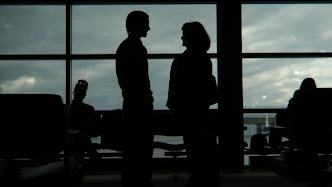Topic #2: Character
First of all, apologies for the delay. You wouldn't know it yet, but we actually have a schedule that looks something like this:
John: Monday-Tuesday
Cole: Wednesday-Friday
Jeremy: Saturday-Sunday
So, as you can see, I've missed my deadline, and were it not for Cole's incessant pestering, I probably would have missed it further.
I've been delayed blog-wise due to final bits of color correction on the trailer and getting everything in order for our sound designer, Jordan Fehr, to take a quick look at any mixing and design tweaks necessary before next week. Why next week? Because Glass City Films is going to the Trail Dance Film Festival in Oklahoma, and we're hoping to have a solid version of the trailer and an investor packet to give to potential producers and distributors.
But enough with excuses and awesomeness. This week's topic centers entirely on character development, something that always seems to be lacking in most of the scripts I work on in Chicago as a cinematographer. One of my central edicts for good storytelling is that plot should follow character, not the other way around. I cite the difference between LOST and Heroes as prime examples of the former and the latter: whereas LOST's conspiracy theories and mythology are firmly rooted in the characters and the emotions that drive them to do such things, Heroes's characters seemingly change on a dime because the plot dictates that they must. One minute, someone has to be a villain; the next, that same person will be saving the life of a person who should be strong-willed yet has decided for this string of episodes to be a flip-flopper.
Cue frustration and rant. But I digress.
What drove me to Separation Anxiety, and what ignites me about its writing, is its to-the-core focus on character development, almost at the expense of what would be considered a typical three-act "plot". Bailey, Jess, and Quinn - and Lily and Mr. Palmer, as well - are all complex characters with shades of grey about their major characteristics, all of which are motivated by choices and events in their lives. I look forward to reading Jeremy's ramble on how he crafted those characters, but that is not my job on this film. My business is cinematography, and how to illustrate each character with imagery and lighting.
My favorite shots in the trailer - look for it next week - are those that evoke certain emotions and feelings about a character or a scene, regardless of what is prettier or not. For example, in Jess' initial confrontation with Mr. Palmer, as she goes to leave, her face is lit with a strong, cool side light, to separate her in color and feeling from Mr. Palmer, who is bathed in a more orange, gentle light. It's not to cast judgment, however, but rather to illustrate that, at this point in the story, Mr. Palmer has settled on his thoughts, and Jess is struggling to come to terms with all of it. And we see that in the wear and tear of the image.
The beauty of feature film work, as opposed to short films, is that the length of the project leaves room for a great deal more nuance. Rather than committing to a single style or a single visual arc, multiple arcs can co-exist. Robert Elswit (Magnolia, There Will Be Blood) and the late Conrad Hall (American Beauty, In Cold Blood) are terrific examples of cinematographers who use all the tools in their bag to achieve these multiple arcs. So too is Robert Richardson, who uses a minimum of six film stocks on almost every film he shoots (JFK, The Good Shepherd) because each stock has its own life and character.
For Separation Anxiety, a few thoughts we had discussed: Jess and Quinn's journey through grief can be a subtle transition from cool, flat tones and hard fixtures to more shapely soft light and warm color schemes. Mr. Palmer's rigid manner can be reflected in claustrophobic framings with longer lenses, but can give way later to wider shots that leave room to breathe. Lily and Quinn's relationship, over the course of the film, can start with a strong degree of contrast and morph into a less harsh, high-key low-fill lighting scheme. All within a general visual scheme dictated by the timeline of events: flashbacks are saturated, almost like porcelain dolls, and the present is melancholy, with a bleached, worn look to it. Think of the way memory is toyed with visually in Eternal Sunshine of the Spotless Mind (my favorite film, but that's for another topic).
Another idea brought up was to keep elements of Bailey and Mr. Palmer's faith life present in the frame. As Mr. Palmer's faith is so tested by the possibility of Bailey having committed suicide, we thought it a nice visual reminder as opposed to a wordy explanation of Mr. Palmer's history with God and with church. In the trailer, there's a simple but effective image through the mirror of Mr. Palmer crying on Bailey's bed. A crucifix plays in the foreground, subtly, and the image is incredibly evocative.
So, that's it for my ramble. Don't want to give away ALL the surprises, do we?
Let's hear your thoughts and comments. Based on your general knowledge of the script, what visuals come to mind? What films best play in your head as using multiple visual paths to tell the same story? Do you prefer the more stylized visuals of, say, a Quentin Tarantino film or a Steven Spielberg film, or the subtle drawings of the Robert Elswits and the Anthony Dod Mantles of the world? (The latter, by the way, recently shot Slumdog Millionaire, and I encourage you all to go see it multiple times.) Have at it!





0 comments:
Post a Comment